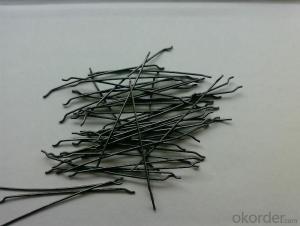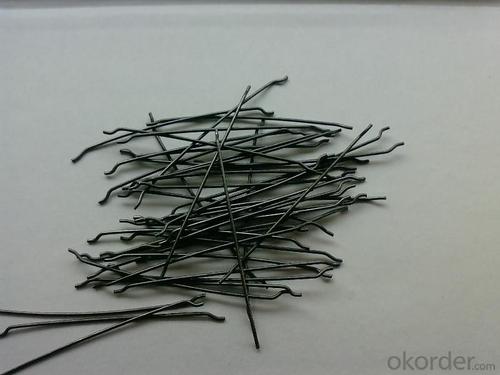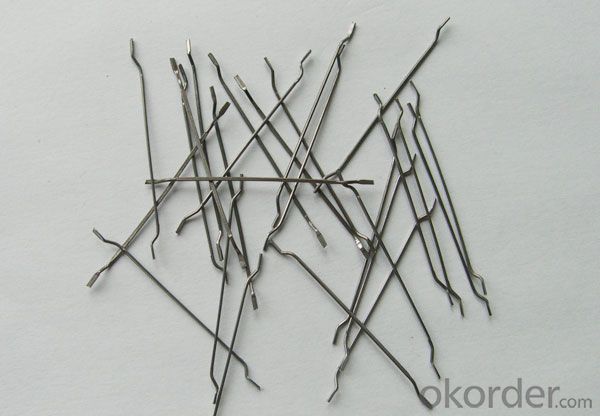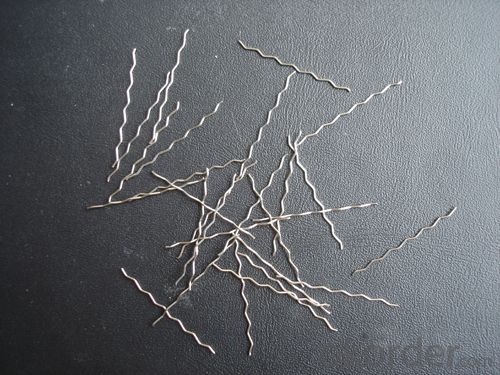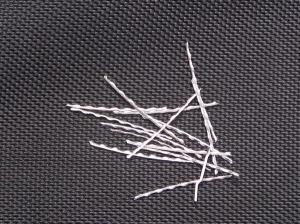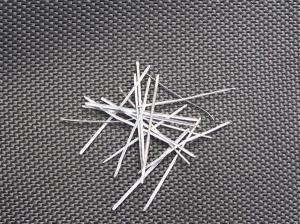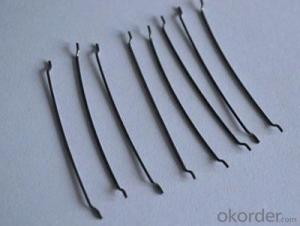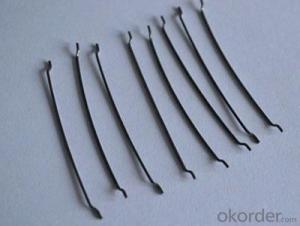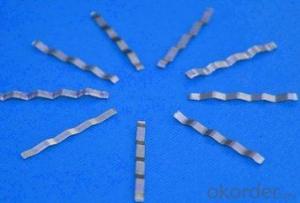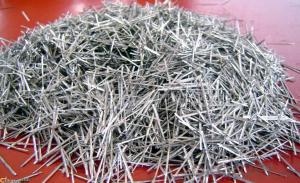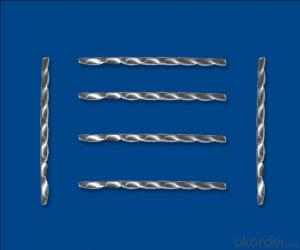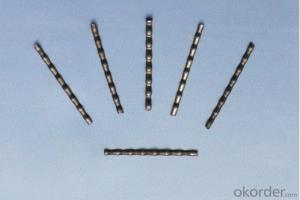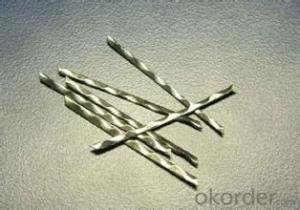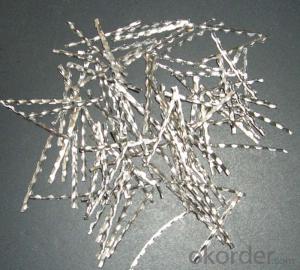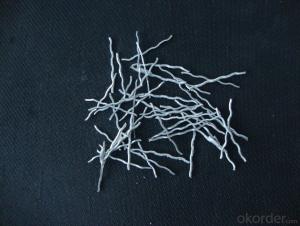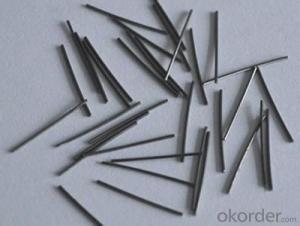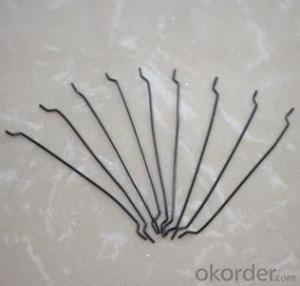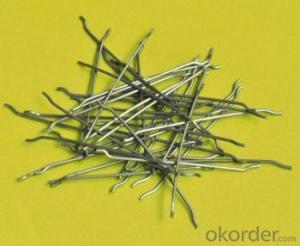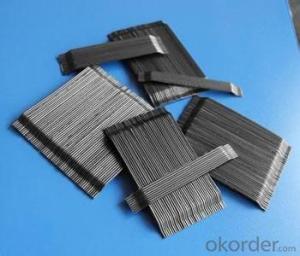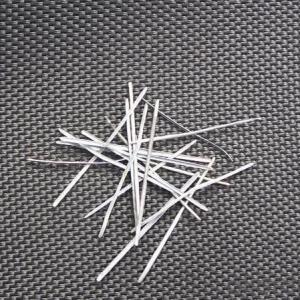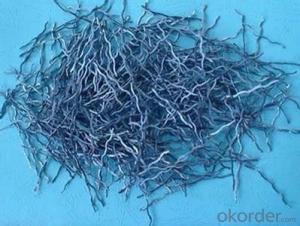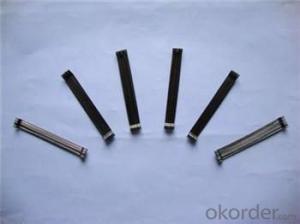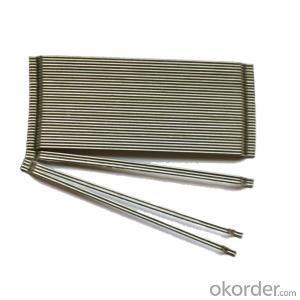Melt Extract Stainless Steel Fiber as Concrete Admixtures CNBM
- Loading Port:
- Tianjin
- Payment Terms:
- TT OR LC
- Min Order Qty:
- 2000 kg
- Supply Capability:
- 250000 kg/month
OKorder Service Pledge
OKorder Financial Service
You Might Also Like
Quick Details
Place of Origin: Shandong, China (Mainland), Shandong, China (Mainland)
material: steel wire
type: wavy steel fiber
shape: corrugated flat fiber
usage: concrete reinforcement
appearance: clear and bright
Product features
steel fiber are for concrete construction, greatly improves concrete bonding and tensile strength .
The steel fiber is made of high-quality low carbon steel wire,with the characteristic of the high tensile strength,good toughness,etcs.This product is widely used in the construction fields for concrete reinforcement
Specifications
| The Specification of Hooker Ends Steel Fiber | ||||
| TYPE | Diameter(mm) | Length(mm) | Length/Diameter | Tensile strength |
| LB-60/60 | 1.0 | 60 | 60 | >=1000Mpa |
| LB-50/50 | 1.0 | 50 | 50 | >=1000Mpa |
| LB-65/60 | 0.9 | 60 | 65 | >=1000Mpa |
| LB-55/50 | 0.9 | 50 | 55 | >=1000Mpa |
| LB-80/60 | 0.75 | 60 | 80 | >=1000Mpa |
| LB-45/35 | 0.75 | 35 | 45 | >=1000Mpa |
| LB-55/30 | 0.55 | 30 | 55 | >=1000Mpa |
| LB-60/30 | 0.5 | 30 | 60 | >=1000Mpa |
| LB-50/25 | 0.5 | 25 | 50 | >=1000Mpa |
| LB-60/25 | 0.4 | 25 | 60 | >=1000Mpa |
Picture
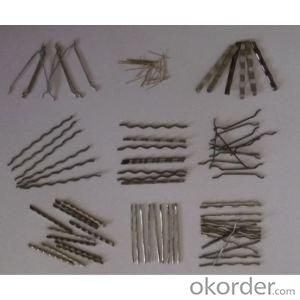
steel fiber for concrete reinforcement
steel fiber are for concrete construction, greatly improves concrete bonding and tensile strength .
The steel fiber is made of high-quality low carbon steel wire,with the characteristic of the high tensile strength,good toughness,etcs.This product is widely used in the construction fields for concrete reinforcement
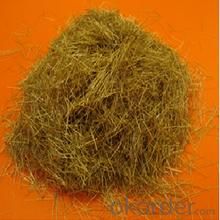
FAQ
we can produce any type steel fiber and of course we can make production according to your requirement
we have specilize in this field for almost 10 years ,with good quality and competitive price
- Q: Can melt extract stainless steel fiber be used in high-density concrete?
- Yes, melt extract stainless steel fiber can be used in high-density concrete. Stainless steel fibers are commonly added to concrete mixes to improve the overall strength, durability, and crack resistance of the concrete. The high-density concrete, which is typically used in applications where a denser and stronger material is required, can benefit from the addition of stainless steel fibers. These fibers help to reinforce the concrete and enhance its ability to withstand heavy loads, impact, and other stressors. Additionally, stainless steel fibers have excellent corrosion resistance properties, making them suitable for use in high-density concrete that may be exposed to harsh environmental conditions. Overall, the use of melt extract stainless steel fibers in high-density concrete can result in a stronger and more durable material that is better suited for demanding applications.
- Q: What is the effect of melt extract stainless steel fiber on the fatigue behavior of concrete beams?
- Concrete beams benefit greatly from the addition of melt extract stainless steel fibers, as they positively impact the beams' fatigue behavior. Stainless steel fibers, known for their high tensile strength and resistance to corrosion, enhance the durability and performance of concrete structures when subjected to cyclic loading conditions. By acting as reinforcement, the stainless steel fibers evenly distribute stress throughout the structure when added to concrete beams. This reinforcement significantly improves the beams' fatigue resistance, enabling them to endure repeated loading and unloading cycles without incurring substantial damage or failure. The presence of stainless steel fibers in concrete beams also aids in reducing crack propagation and controlling microcrack growth. This is achieved by the fibers bridging across cracks, preventing their widening or further propagation. Consequently, the overall fatigue life of the beams is increased. Furthermore, the incorporation of melt extract stainless steel fibers enhances the ductility of concrete, rendering it more resistant to cracking and enhancing its energy absorption capabilities. This improved ductility contributes to the overall fatigue performance of the beams, allowing them to deform and absorb energy more effectively, thereby minimizing the risk of sudden failure. In conclusion, the addition of melt extract stainless steel fibers to concrete beams has a positive impact on their fatigue behavior. It improves fatigue resistance, reduces crack propagation, enhances ductility, and ultimately increases the overall durability and lifespan of the beams when subjected to cyclic loading conditions.
- Q: What is the effect of melt extract stainless steel fiber on the thermal conductivity of concrete?
- The inclusion of melt extract stainless steel fiber in concrete tends to enhance its thermal conductivity. The fibers act as heat conductors within the concrete matrix, facilitating the transfer of heat throughout the material. This results in improved thermal conductivity and better heat distribution within the concrete structure.
- Q: Can melt extract stainless steel fiber be used in fiber-reinforced polymers?
- Yes, melt extract stainless steel fiber can be used in fiber-reinforced polymers (FRPs). Stainless steel fibers are often added to polymer matrices to enhance their mechanical properties such as tensile strength, flexural strength, and impact resistance. The melt extract stainless steel fibers are obtained through a specialized process that ensures uniformity and high quality. The addition of stainless steel fibers to FRPs can provide several benefits. Firstly, the fibers can enhance the overall strength and durability of the composite material, making it suitable for applications that require high strength-to-weight ratio. Secondly, stainless steel fibers can improve the fracture toughness of the FRPs, making them more resistant to crack propagation. This can be particularly important in applications where impact resistance is crucial. Additionally, the corrosion resistance of stainless steel fibers can be advantageous in environments where the FRPs may be exposed to harsh conditions, such as moisture, chemicals, or high temperatures. The stainless steel fibers can prevent corrosion of the composite material, increasing its lifespan and reliability. Overall, the use of melt extract stainless steel fibers in fiber-reinforced polymers can significantly enhance the mechanical properties and durability of the composite material, making it suitable for a wide range of applications in industries such as automotive, construction, aerospace, and marine.
- Q: What are the advantages of using melt extract stainless steel fiber?
- There are numerous benefits to utilizing melt extract stainless steel fiber in a variety of applications. To begin with, melt extract stainless steel fiber boasts exceptional strength and durability. Crafted from stainless steel, renowned for its high tensile strength and resistance to corrosion, the fibers are well-suited for use in demanding environments where alternative materials may falter. Furthermore, the utilization of melt extract stainless steel fiber can notably enhance the mechanical properties of a material. When introduced to concrete or other composites, the fibers serve as reinforcement, enhancing toughness, ductility, and crack resistance. As a result, structures become more resilient and long-lasting. In addition, melt extract stainless steel fiber exhibits excellent thermal properties. With a high melting point, it can withstand extreme temperatures without deformation or compromising its structural integrity. Consequently, it is an ideal choice for applications involving high heat or fire hazards. Moreover, melt extract stainless steel fiber offers electromagnetic shielding capabilities. Its conductive nature effectively blocks electromagnetic waves, preventing interference and safeguarding sensitive electronic equipment. This renders it suitable for industries such as aerospace, telecommunications, and electronics. Furthermore, the utilization of melt extract stainless steel fiber can also yield long-term cost savings. By reinforcing materials and structures, it prolongs their lifespan and diminishes the necessity for frequent repairs or replacements. Over time, this can result in substantial cost savings. In conclusion, the advantages of melt extract stainless steel fiber encompass exceptional strength and durability, enhanced mechanical properties, impressive thermal properties, electromagnetic shielding capabilities, and potential cost savings. These qualities establish it as a versatile and dependable choice for various applications across diverse industries.
- Q: Can melt extract stainless steel fiber be used in the construction of power plant structures?
- Certainly, the utilization of melt extract stainless steel fiber is possible in the construction of power plant structures. In construction applications, stainless steel fibers offer numerous benefits, such as their exceptional strength, resistance to corrosion, and long-lasting nature. In power plants, where structures are subjected to elevated temperatures, extreme pressures, and harsh environments, stainless steel fibers can serve as an additional reinforcement to concrete or other construction materials. The presence of stainless steel fibers aids in enhancing the structural integrity of power plant structures by bolstering the concrete's ability to withstand cracking, spalling, and thermal shock. They effectively mitigate shrinkage and minimize crack formation, thus ensuring the durability and safety of power plant facilities. Furthermore, melt extract stainless steel fibers possess remarkable thermal conductivity, enabling them to efficiently disperse heat and prevent localized hot spots within construction materials. This characteristic is particularly crucial in power plants, where excessive heat can lead to structural harm and compromise the overall performance of the facility. Moreover, stainless steel fibers are non-magnetic, rendering them suitable for use in power plants that necessitate non-magnetic materials due to specific equipment or operational requirements. To conclude, the employment of melt extract stainless steel fibers is indeed feasible in the construction of power plant structures. Their exceptional strength, corrosion resistance, durability, and thermal conductivity make them an invaluable addition in guaranteeing the structural integrity and longevity of power plant facilities.
- Q: What is the impact of melt extract stainless steel fiber on the thermal properties of concrete?
- The thermal properties of concrete are greatly impacted by the presence of melt extract stainless steel fiber. To enhance the concrete's thermal conductivity and heat resistance, stainless steel fibers are incorporated into the concrete mixture. These fibers serve as conduits for heat within the concrete structure, enabling better heat transfer throughout the entire building. By adding stainless steel fibers, the thermal conductivity of concrete is increased, resulting in more efficient heat transfer within the material. This is particularly advantageous in situations where effective heat dissipation is crucial, such as in the construction of high-temperature industrial facilities or fire-resistant structures. Additionally, the inclusion of stainless steel fibers helps mitigate the risk of thermal cracking in concrete. When exposed to high temperatures, concrete undergoes thermal expansion, which can lead to the formation of cracks. However, by incorporating stainless steel fibers, the heat is distributed more evenly throughout the concrete, reducing the likelihood of localized thermal stresses and consequent cracking. Moreover, stainless steel fibers contribute to enhancing the fire resistance of concrete. By reinforcing the concrete and preventing the propagation of cracks and spalling caused by thermal shock during a fire, the addition of these fibers improves the overall fire rating of concrete structures. In conclusion, the incorporation of melt extract stainless steel fibers in concrete has a significant impact on its thermal properties. It enhances thermal conductivity, reduces the risk of thermal cracking, and increases fire resistance. These advantages make stainless steel fiber-reinforced concrete the preferred choice for applications where thermal performance and resistance to high temperatures are of utmost importance.
- Q: Can melt extract stainless steel fiber be used in wastewater treatment plant construction?
- Yes, melt extract stainless steel fiber can be used in wastewater treatment plant construction. Stainless steel fibers are commonly used in construction materials for their high strength, durability, and resistance to corrosion. In wastewater treatment plants, where there is constant exposure to moisture and chemicals, the use of stainless steel fibers can enhance the performance and longevity of the construction materials. These fibers can be incorporated into concrete, cement, or other composite materials to improve their mechanical properties and increase their resistance to cracking, spalling, and deterioration. Additionally, stainless steel fibers can also help to reduce the formation of cracks and enhance the overall structural integrity of the construction elements. Therefore, the use of melt extract stainless steel fibers can be a viable option for wastewater treatment plant construction.
- Q: How does melt extract stainless steel fiber improve the impact resistance of concrete pipes?
- Melt extract stainless steel fiber is a reinforcing material that is commonly used in concrete pipes to enhance their impact resistance. The addition of these fibers to the concrete mixture significantly improves the overall performance and durability of the pipes. The primary way in which melt extract stainless steel fiber enhances the impact resistance of concrete pipes is through its ability to distribute and dissipate energy upon impact. When a force is applied to the pipe, the fibers act as mini-reinforcements within the concrete matrix, effectively absorbing and dispersing the energy throughout the structure. This energy dispersion mechanism prevents the concentration of stress in specific areas of the pipe, which reduces the likelihood of cracks or fractures forming upon impact. By evenly distributing the energy, the stainless steel fibers help to increase the overall strength and resilience of the concrete pipe, making it more capable of withstanding heavy loads and external forces. Additionally, the high tensile strength of melt extract stainless steel fibers further contributes to the improved impact resistance of the concrete pipes. These fibers are typically manufactured with a diameter ranging from 0.1mm to 0.5mm and possess excellent tensile strength properties. As a result, they provide an additional layer of reinforcement to the concrete, effectively reinforcing the matrix and making it more resistant to impact-induced damage. Furthermore, melt extract stainless steel fibers also enhance the durability of the concrete pipes by preventing the propagation of cracks. In the event of an impact, the fibers act as bridging elements across cracks, effectively inhibiting their growth and preventing them from spreading further. This crack inhibition property significantly improves the overall integrity of the pipe, reducing the risk of failure and extending its service life. In conclusion, melt extract stainless steel fiber improves the impact resistance of concrete pipes by distributing and dissipating energy, increasing tensile strength, and preventing crack propagation. These fibers play a crucial role in enhancing the overall durability and performance of the concrete pipes, making them more capable of withstanding external forces and heavy loads.
- Q: How does melt extract stainless steel fiber improve impact resistance in concrete?
- The impact resistance of concrete is enhanced by melt extract stainless steel fiber, as it reinforces the concrete and improves its structural integrity. During the mixing process, the fibers are dispersed throughout the concrete matrix, creating a reinforcement system in the form of a three-dimensional network. When a load or impact is applied to the concrete, the stainless steel fibers help distribute the stress and absorb the energy. This action prevents cracks from propagating and reduces the chances of concrete failure. The fibers function as miniature reinforcement bars, enhancing the concrete's tensile strength and ductility. Additionally, the melt extract stainless steel fibers have a high aspect ratio, which means they are long and thin. This attribute further enhances their effectiveness in impact resistance. The fibers can bridge and connect cracks in the concrete, inhibiting their growth and preventing further damage. The impact resistance properties of the stainless steel fibers are also attributed to the stainless steel material itself. Stainless steel is renowned for its strength and durability, making it an excellent choice for reinforcing concrete. It also has exceptional corrosion resistance, ensuring the long-term performance and durability of the concrete structure. In summary, melt extract stainless steel fiber improves the impact resistance of concrete by providing additional reinforcement, distributing stress, absorbing energy, preventing crack propagation, enhancing tensile strength, and bridging cracks. Its high aspect ratio and corrosion-resistant properties further contribute to its effectiveness in enhancing the overall impact resistance of concrete structures.
Send your message to us
Melt Extract Stainless Steel Fiber as Concrete Admixtures CNBM
- Loading Port:
- Tianjin
- Payment Terms:
- TT OR LC
- Min Order Qty:
- 2000 kg
- Supply Capability:
- 250000 kg/month
OKorder Service Pledge
OKorder Financial Service
Similar products
Hot products
Hot Searches
Related keywords
